Hollywood’s Blacklists: A Political and Cultural History, Reynold Humphries, Edinburgh University Press, 2008, 184 pp.
Reynold Humphries, former professor of Film Studies at the University of Lille 3, has written a valuable new account of the blacklisting of left-wing writers, actors, directors and producers in the American film industry in the late 1940s and early 1950s. This disgraceful episode, in which the FBI, ultra-right elements, official liberalism and Hollywood executives all played their parts, has had far-reaching consequences, not only for the film industry, but American society and culture as a whole.
One feature of the reactionary climate of the 1990s, following the collapse of the Soviet Union, was the attempted rehabilitation of the postwar witch-hunting. Openly right-wing proponents reclaimed FBI chief J. Edgar Hoover, the members of the House Un-American Activities Committee, Senator Joseph McCarthy and the rest of that filthy crowd as defenders of the US against its enemies.
The slightly more respectable, liberal, sometimes ex-leftist version acknowledged that HUAC, McCarthy and company might have exaggerated and, after all, there were excesses, but anti-communism remained an essentially noble cause, pitting democratic institutions against totalitarianism. Communist Party members in the film industry, according to this argument, were more or less the equivalent of GPU [Soviet secret police] agents.
Humphries’ book is unapologetically leftist and treats the anti-communist cohort with the contempt it deserves. A settling of accounts with this piece of history is no small matter. Until American artists and intellectuals finally get over their aversion to or fear of socialism, it will be difficult to make much progress. It’s impossible in our day to paint the sharpest pictures of life without the living presence of a Marxist critique of society.
For opponents of the political and economic status quo, the events of the 1940s and 1950s in Hollywood raise a host of complex issues bound up with the Second World War, postwar society in the US, American liberalism, the film industry, the Communist Party and the general problems of the American left. Humphries approaches certain of these questions, and leaves some of the others aside.
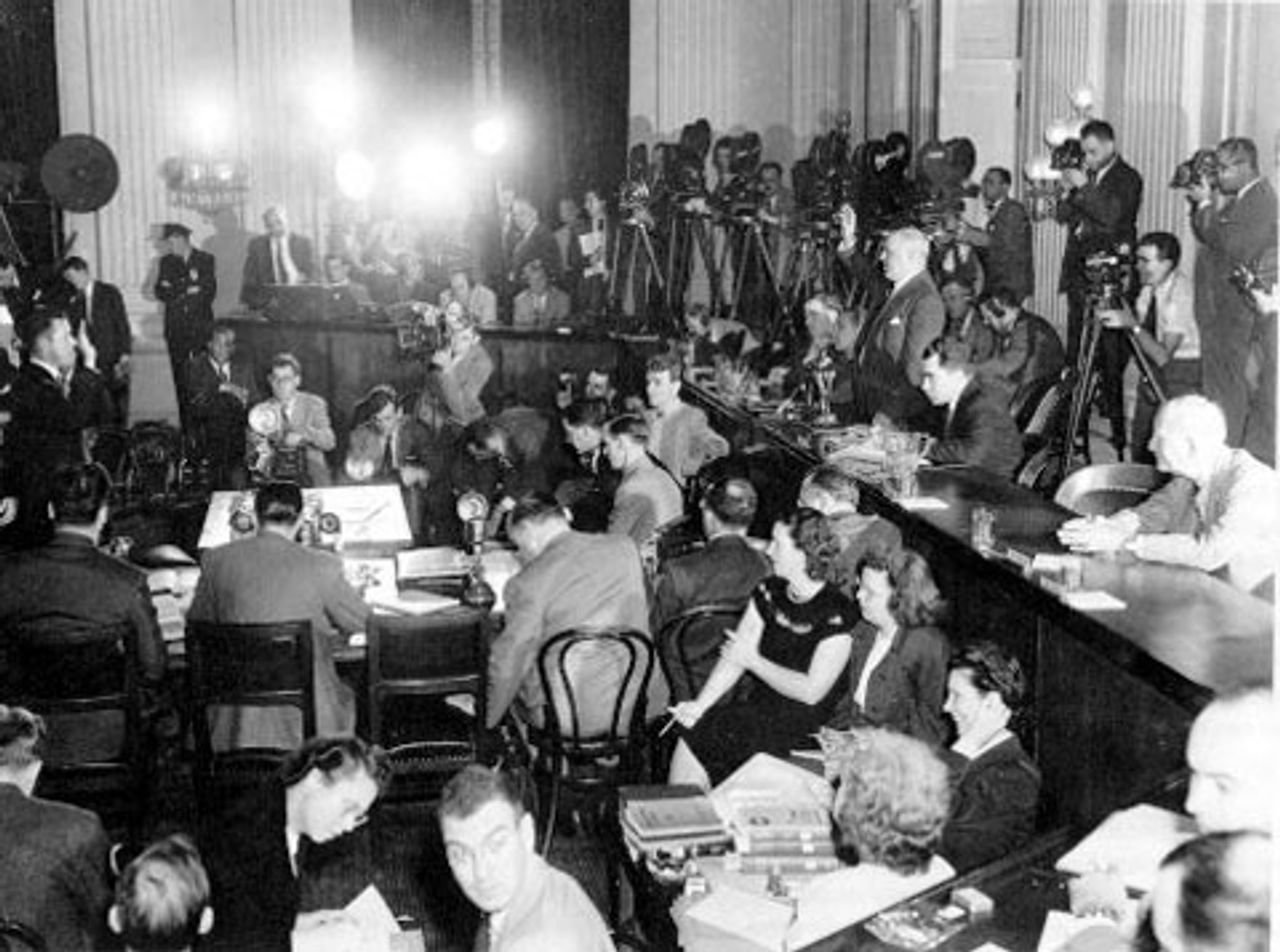 HUAC hearings — 1951-53
HUAC hearings — 1951-53
Humphries broadly presents the anti-communist reaction of the postwar years as an effort by figures such as Hoover to defend the existing social order against the radicalism that had emerged in the working class and other social layers during the Great Depression. These oppositional elements had “joined forces in ways that threatened simultaneously the status quo, the supposedly classless nature of American society and the relations between groups and classes based on power structures so long in place that they were taken for granted.” (p. 3)
The monograph treats a number of processes and events in some detail: the bitter union struggles in Hollywood in the 1930s and 1940s; the first round of Hollywood HUAC hearings in October 1947, which brought about the blacklist; the committee’s hearings in 1951-1953; the “Anti-Communist Crusade on the Screen” and the consequences of the purges for its victims.
While all of this history is important, some aspects of it deserve special emphasis.
One of the first things Humphries does, quite rightly, is to establish the political credentials of those who persecuted the Communists and others. Who were these stalwarts?
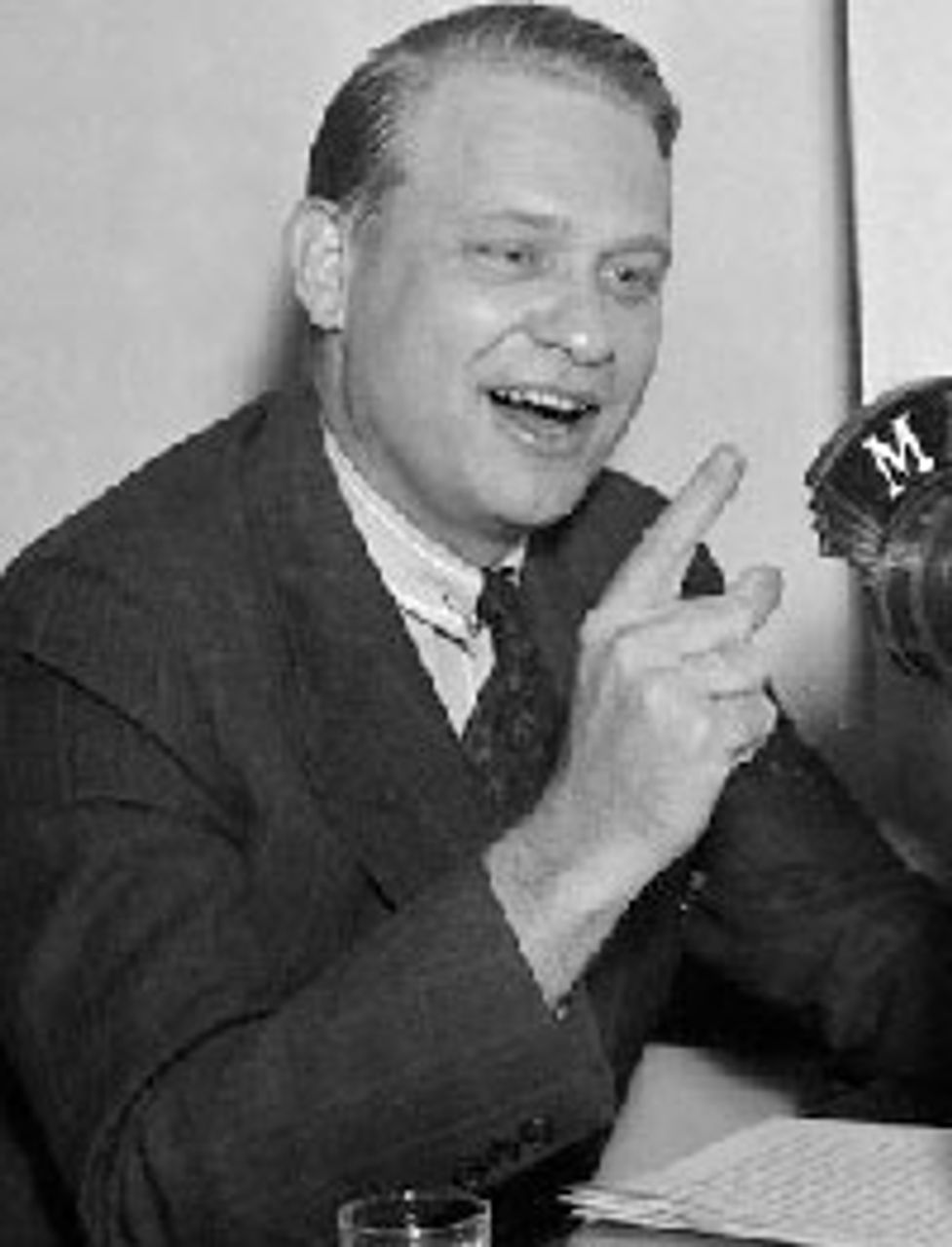 Rep. Martin Dies
Rep. Martin Dies
Men like Democratic Congressman Martin Dies of Texas, the first HUAC chairman “to seek out Reds in Hollywood (in 1940),” who was “greatly admired and applauded by the Nazi Propaganda Ministry.” (p.13) Dies was a supporter of the Ku Klux Klan and spoke at several of its rallies. “Moreover, Dies was a disciple of the first Chairman of HUAC, Hamilton Fish, an ardent pro-Nazi who considered Communists a danger because of their support for complete equality between whites and blacks, including intermarriage.” (p. 78)
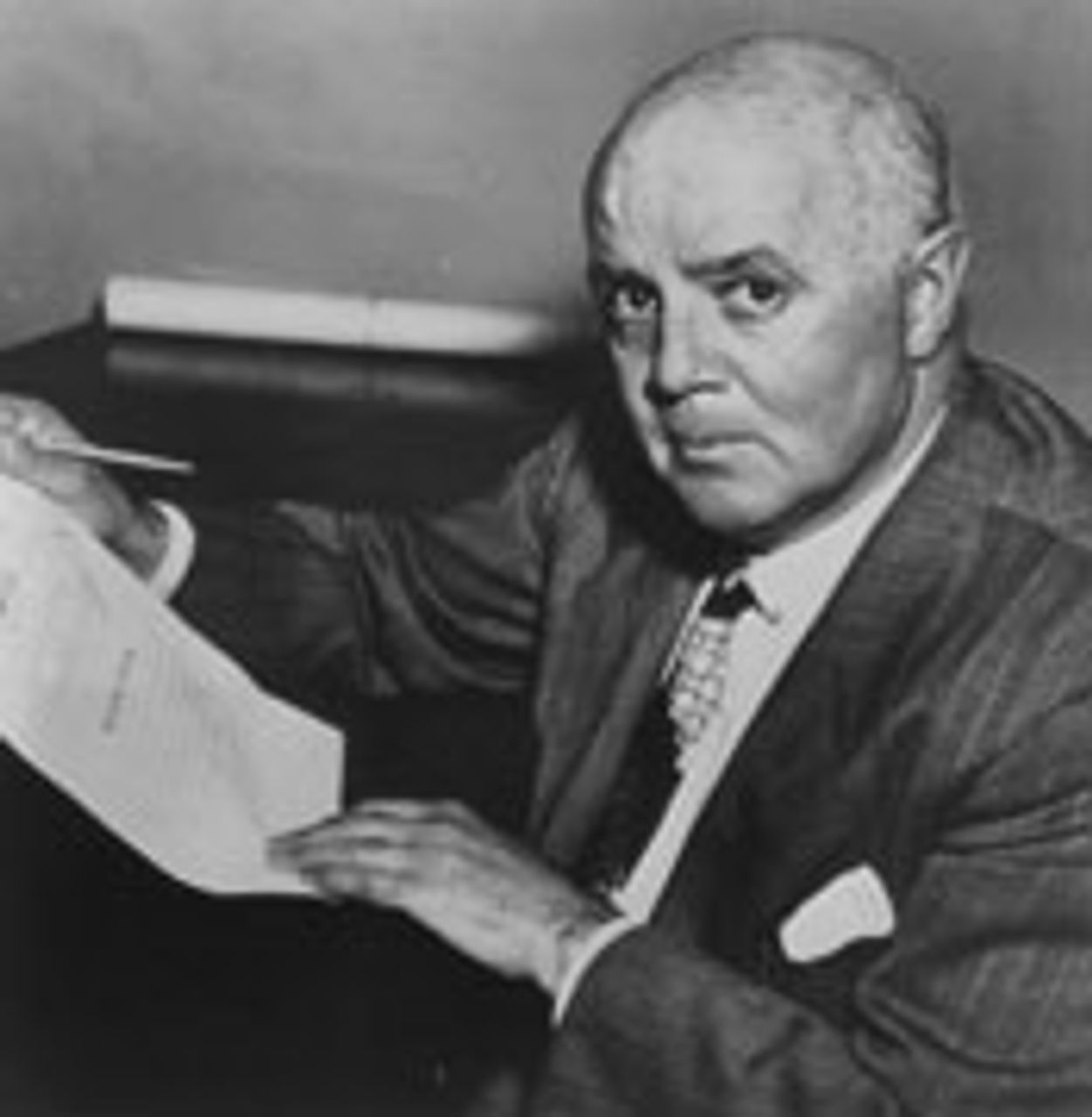 Rep. J. Parnell Thomas
Rep. J. Parnell Thomas
Or New Jersey Republican Rep. J. Parnell Thomas, chairman of HUAC at the time of the 1947 hearings, who helped suppress the democratic rights of the Hollywood Ten, and a pathological anti-communist. Thomas, who equated the New Deal with communism, was often cited in Scribner’s Commentator, a magazine commonly referred to as the “American Nazi Bible.” He was later jailed for fraud.
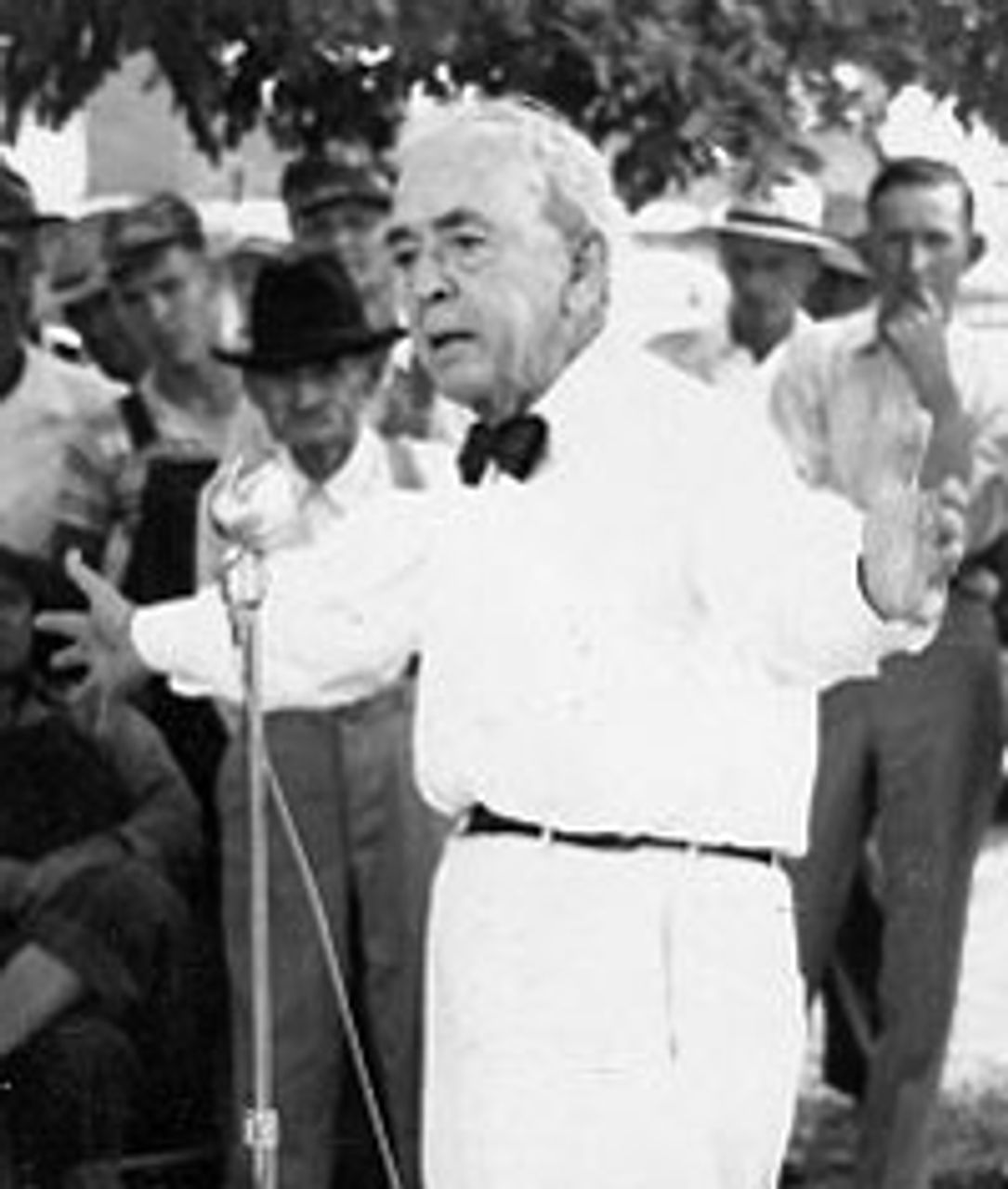 Rep. John Rankin
Rep. John Rankin
Perhaps the most noxious figure of them all: Democratic Congressman and HUAC member John Rankin of Mississippi, an out-and-out fascist. Humphries writes, “Whether calling radio commentator Walter Winchell a ‘slime-mongering kike’ or giving the Jewish names of Hollywood personalities on the floor of Congress, Rankin was allowed to spew forth hate because he served a purpose: he rallied the electorate of the south around him—the Democratic Party needed the southern vote to beat the Republicans—and kept alive the myth of the Judeo-Bolshevik conspiracy.” (p. 12)
Prior to the outbreak of the Second World War, film studio executives, many of them Jewish, attempted to maintain warm relations with the Italian and German fascist regimes for business reasons. Benito Mussolini’s son, Vittorio, spent some time in Hollywood; producer Hal Roach hoped the younger Mussolini would take part in a new production company. The latter was already a contributor to the press empire of right-winger William Randolph Hearst.
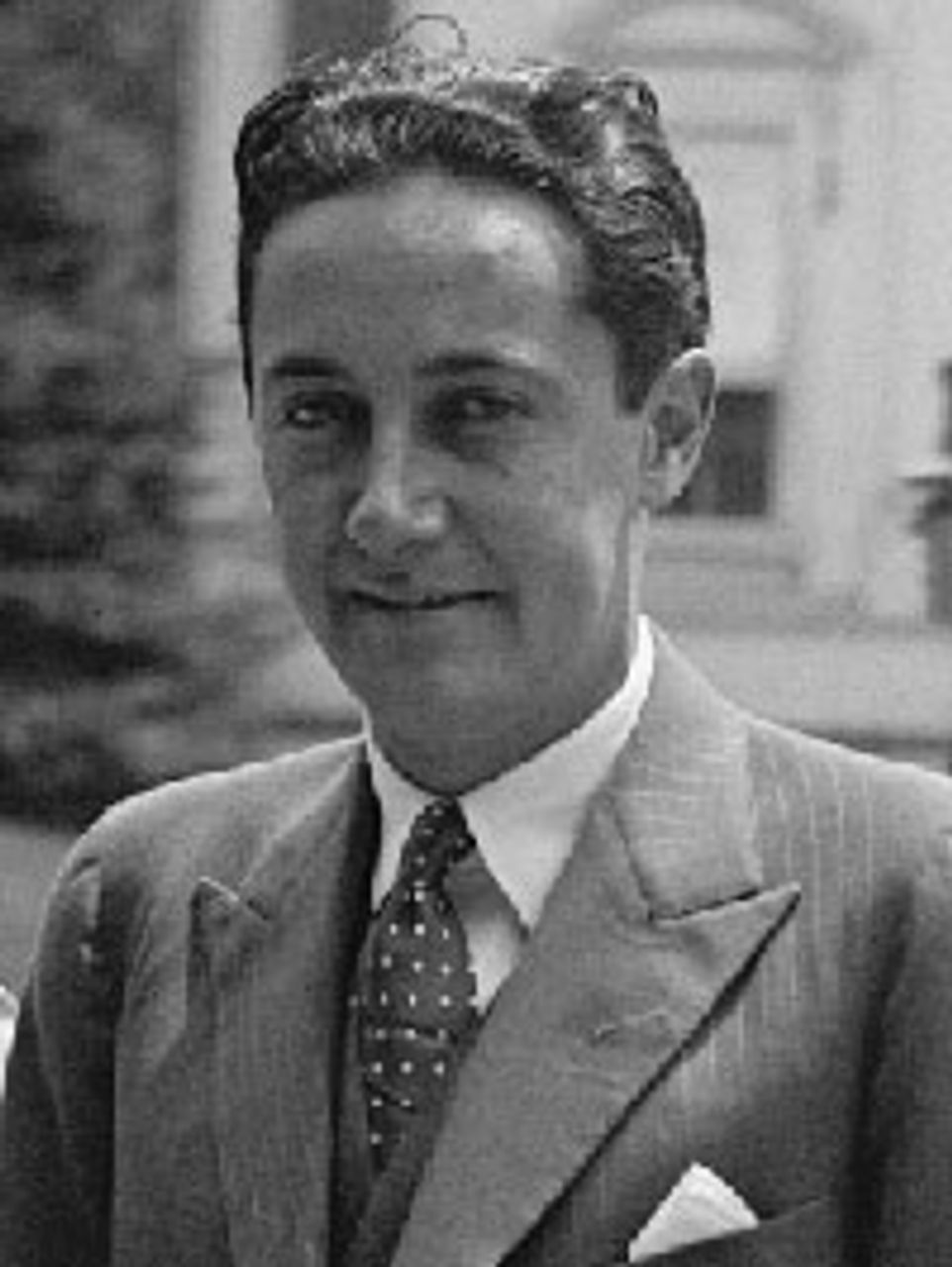 Irving Thalberg of MGM
Irving Thalberg of MGM
MGM’s Irving Thalberg returned from a visit to Germany in 1934 and declared “Hitler and Hitlerism will pass; the Jews will still be there,” while admitting that “a lot of Jews will lose their lives.” (p.15)
“After Hitler annexed Austria in 1938,” notes Humphries, “Fox, Paramount and MGM (all of whose bosses were Jewish) not only maintained their offices in that country but dismissed Jewish executives and employees in Vienna in order to appease Hitler.” (pp. 15-16)
So much for the democratic sensibilities of the American ruling elite and the Hollywood studios and their later claims to be resisting “communist despotism.”
Humphries lays considerable stress on the labor struggles in the film industry in the 1930s and the immediate postwar years.
Screenwriters and actors began their union organizing efforts in the midst of the Depression. One of the catalysts was the attempt by the studios to cut wages by 50 percent in March 1933, the week of Roosevelt’s inauguration. Meanwhile executives lived high off the hog; Samuel Goldywn was reputed to have bet $50,000 on a single card.
Screenwriters were the most consistently left-wing element in Hollywood, and a continual thorn in the side of the studios. The Screen Writers Guild was first established in 1933, with a number of present or future Communist Party members among its founders. Obstructions placed in its path by the employers, including the blacklisting of SWG members and the setting up of a rival, right-wing group, prevented the guild’s full recognition until 1941.
In a chapter entitled “Hollywood Strikes, the Right Strikes Back,” Humphries details “the prolonged and violent strikes that shook Warner Brothers in 1945 and 1946 and the consequent right-wing backlash within the industry (and beyond).” (p. 62)
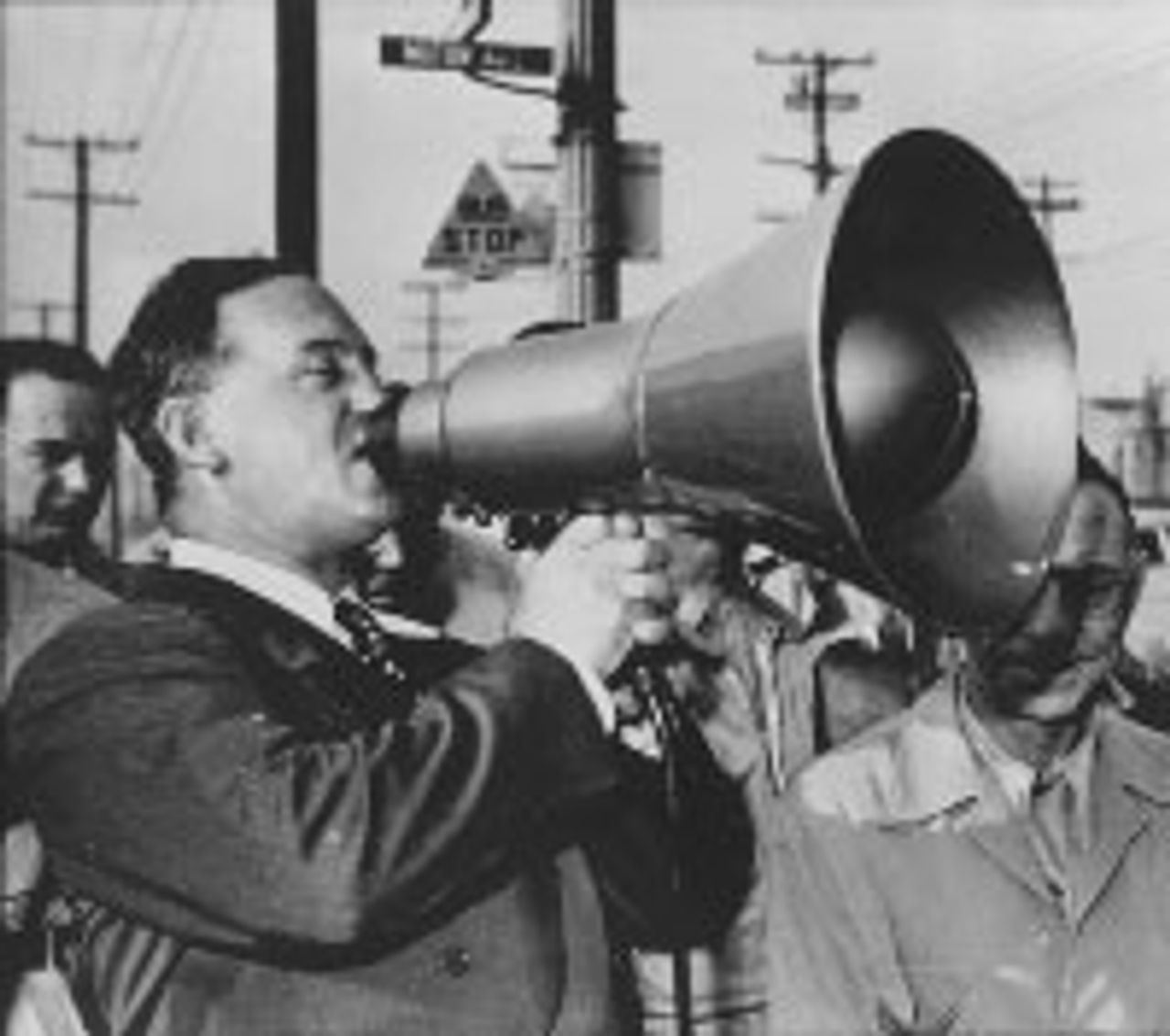 Herbert Sorrell, Hollywood left-wing
Herbert Sorrell, Hollywood left-wing
union leader
The strikes pitted backlot workers under the general leadership of the Conference of Studio Unions (CSU), an effort to create an industrial union in Hollywood, whose president was Herbert Sorrell, a left-winger, against Warners. The first strike lasted from March to October 1945, and faced the bitter opposition of the studios, the authorities and the gangster leadership of rival union IATSE (International Alliance of Theatrical Stage Employees), backed by goons and strike-breakers. As well, because of its policing of the wartime no-strike pledge, the Communist Party opposed the strike (although the walkout had the sympathy of many CP members).
Humphries notes: “The strike of 1945 ended in a stalemate, but everything pointed to it starting up again so that the CSU would be eliminated in favor of the IATSE.” (p. 68)
According to Robert Kenny, former attorney general of California, “the producers and the IATSE had decided by September 1946 to crush the CSU.” (p.68) The collaboration of the anti-communist IATSE leadership and the studio moguls led “to the break-up of the CSU by the end of 1946 and to HUAC coming to Hollywood in 1947.” (p. 65)
As that final comment indicates, the labor struggles in Hollywood always had strong political overtones. As much as the studios prized their profits, powerful elements in the state and intelligence apparatus never lost sight of the ideological issues at stake. Having smashed radical unionism in the film industry, these reactionary elements, whose anti-communism “was soon to be made official policy” (p.71), turned their attention to purging left-wing writers, actors and directors.
Any account of the 1947 HUAC hearings makes for inevitably distressing reading. The infamous conduct of committee chairman Thomas and his fellow witch-hunters, caught on newsreel, who berated, abused and shrieked at the “hostile” witnesses, the so-called Hollywood Ten, all CP members or supporters, captures the poisonous and authoritarian character of the entire project.
“Are you now or have you ever been a member of the Communist Party?” a question that now lives in infamy, was put to the hostile witnesses. The party, of course, was an entirely legal political organization at the time.
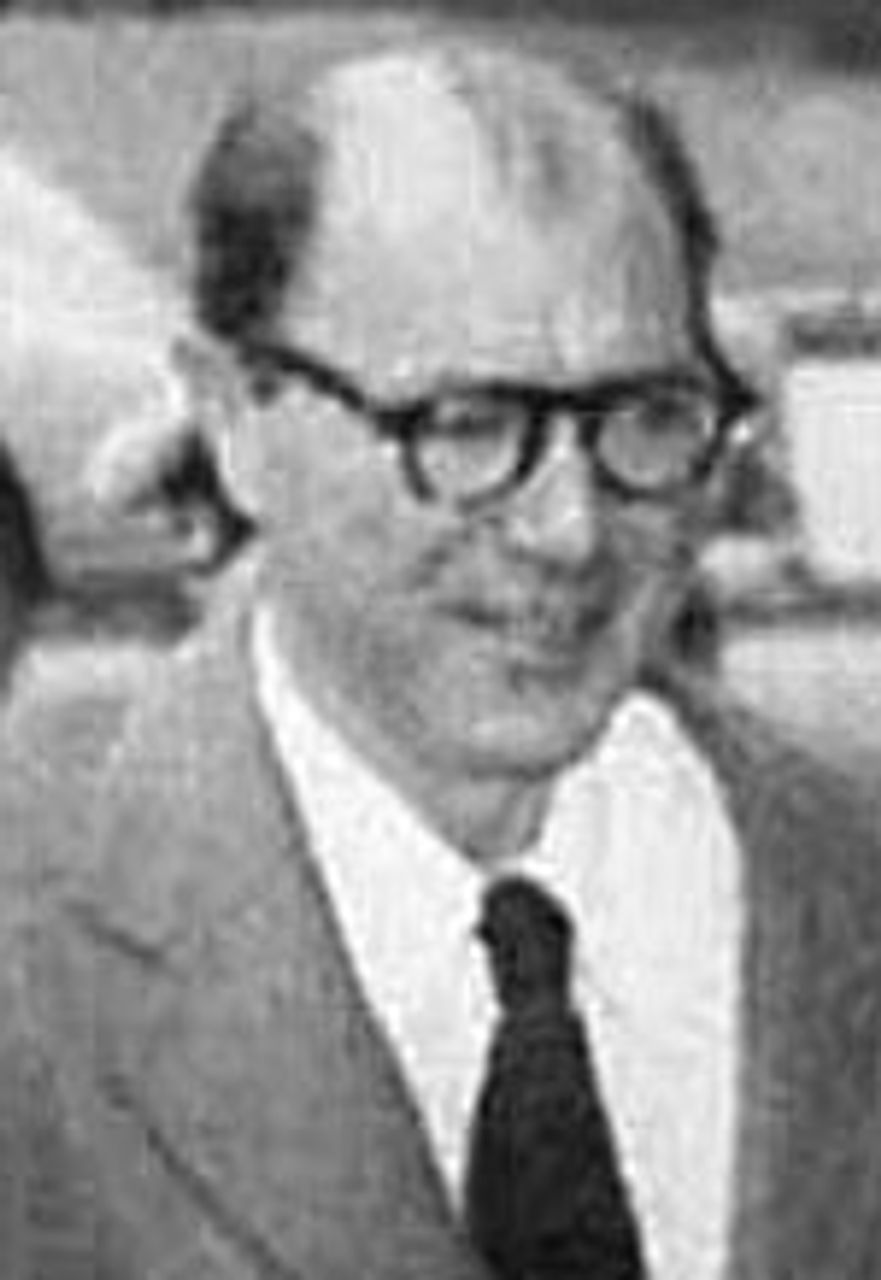 Lester Cole
Lester Cole
Writer Lester Cole was asked if he belonged to the Screen Writers Guild. When Cole began to reply, “I’d be very happy to answer that question. I believe the reason the question is being asked…,” and Thomas “started banging the table with his gavel and shouting ‘No!’ Hollywood on Trial [a documentary about the witch-hunts] shows that he wielded his gavel to the accompaniment of ‘no’ thirteen times.” (p. 87)
Humphries observes that while the FBI had a long list of suspected CP members in Hollywood, HUAC chose its victims with an eye to appealing to the worst instincts of the population: “Most of the Ten were Jews. None had a war record; after all, berating a war hero wearing his medals for the occasion would not go down well with the public.” (p. 82)
The anti-communist purges should be placed in their broad historical setting, the condition of American capitalism at the end of the war as it pursued its geopolitical interests at home and abroad. US imperialism emerged from the war as the dominant world power. As it launched the attempt to “contain” communism internationally, it needed as well to decapitate workers politically at home and make certain that they would not threaten its global designs.
Unable to drive the working population, with its newfound confidence, back to Depression conditions, the ruling elite did the next best thing: it reinforced the grip of the anti-communist AFL-CIO union bureaucracies and helped keep the labor movement subordinate to the Democratic Party and bourgeois politics generally.
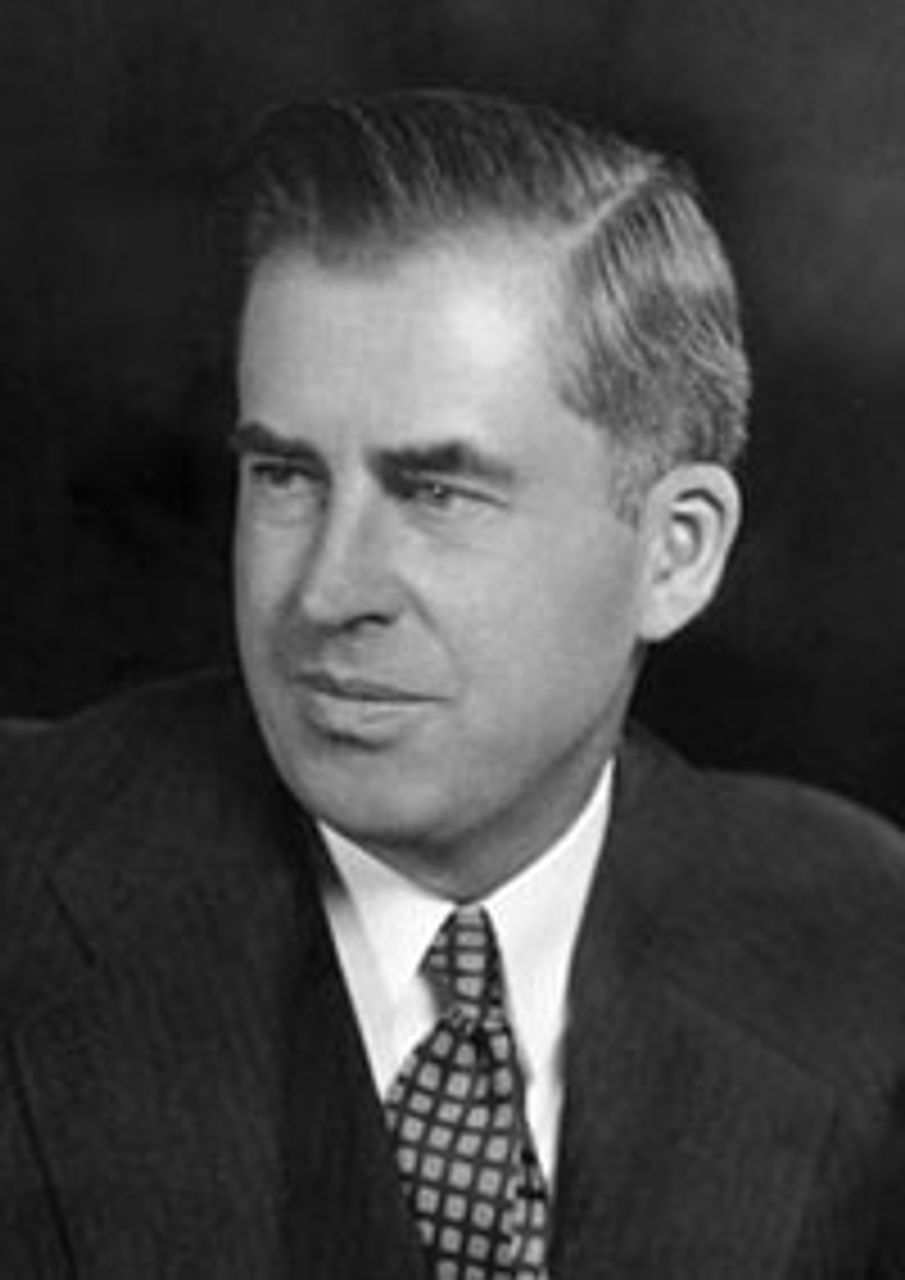 Henry Wallace
Henry Wallace
A rapid transformation of the domestic political situation took place, as we have previously noted, “within a matter of months in 1947-48. Whereas the prospects for third-party candidate and former vice president Henry Wallace, who received the support of the American Stalinists, seemed relatively propitious when he began considering running for president in 1947, his campaign had virtually collapsed by the following summer. The American political and media establishment’s anticommunist campaign had shifted into full gear.” (See —Arthur Miller, an American playwright 21 February 2005)
The exigencies of the new situation in 1947 brought about a change in the attitude of the FBI’s Hoover toward HUAC’s operations. Whereas he had previously resisted cooperating directly with the committee, for his own reasons, now—Humphries remarks—”Hoover’s conviction of the need to expose Communism in Hollywood led him to change his mind and to leak his information [on CP members in the film industry, gathered through break-ins of the party’s offices] covertly—and illegally—to HUAC Chairman J. Parnell Thomas and [HUAC Chief Investigator] Robert Stripling.” (p.80)
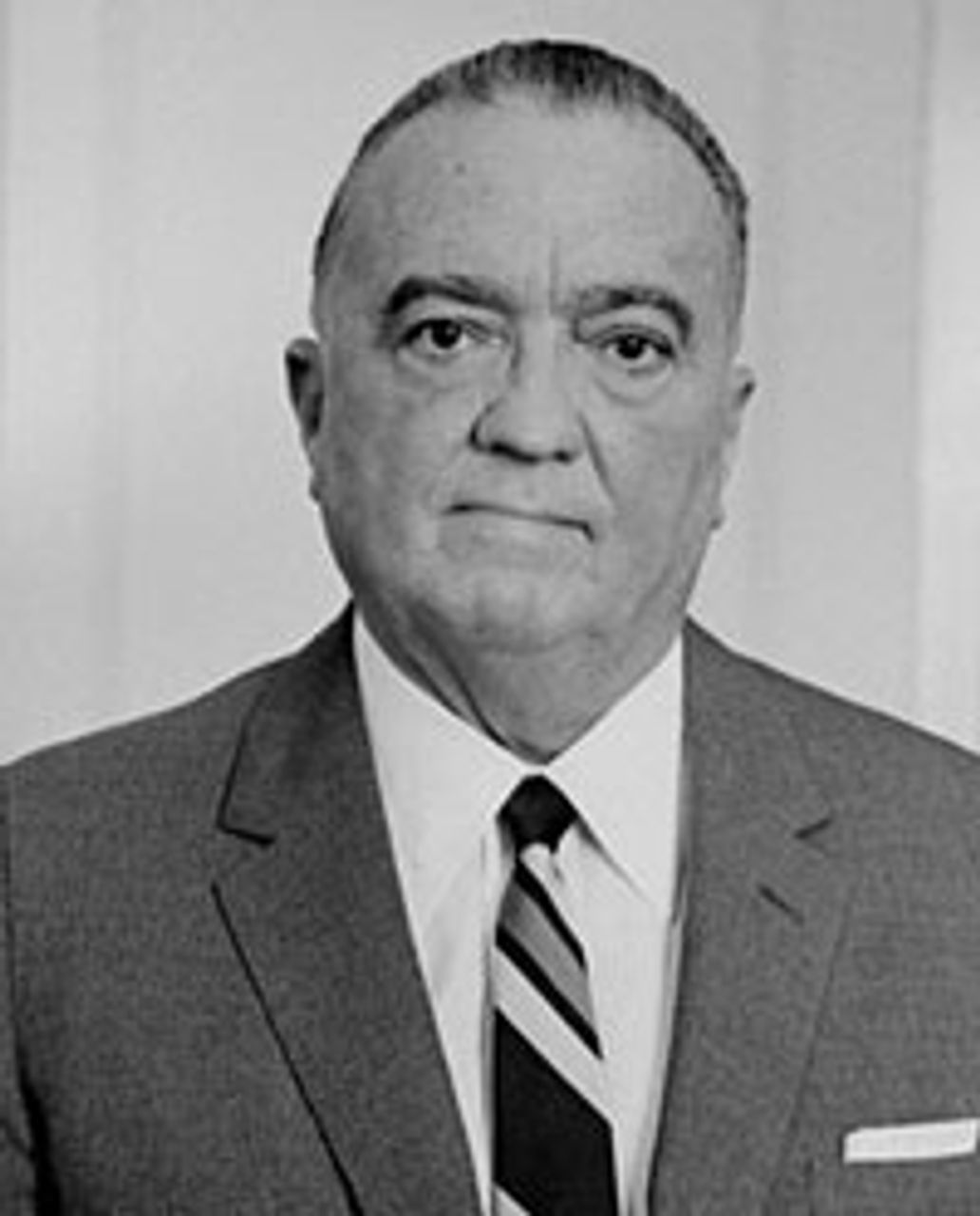 J. Edgar Hoover
J. Edgar Hoover
Immense political pressure was brought to bear on those Hollywood liberals and lefts who initially stood up against the HUAC hearings. Twenty-nine figures in the motion picture industry, supporters of the Committee for the First Amendment, attended the sessions in Washington, the most famous of them being Humphrey Bogart. The CFA was founded by directors John Huston and William Wyler, writer Philip Dunne and actor Alexander Knox.
The CFA came under attack by right-wing journalists, including film industry shills such as gossip columnist Hedda Hopper; the group was denounced on the floor of the House of Representatives by Mississippi’s Rankin. Humphries notes, “The verbal violence of the Hearings had unnerved the CFA.” (p.95) Politically ill-equipped, and not feeling mass support behind them, the Hollywood liberals folded their tent.
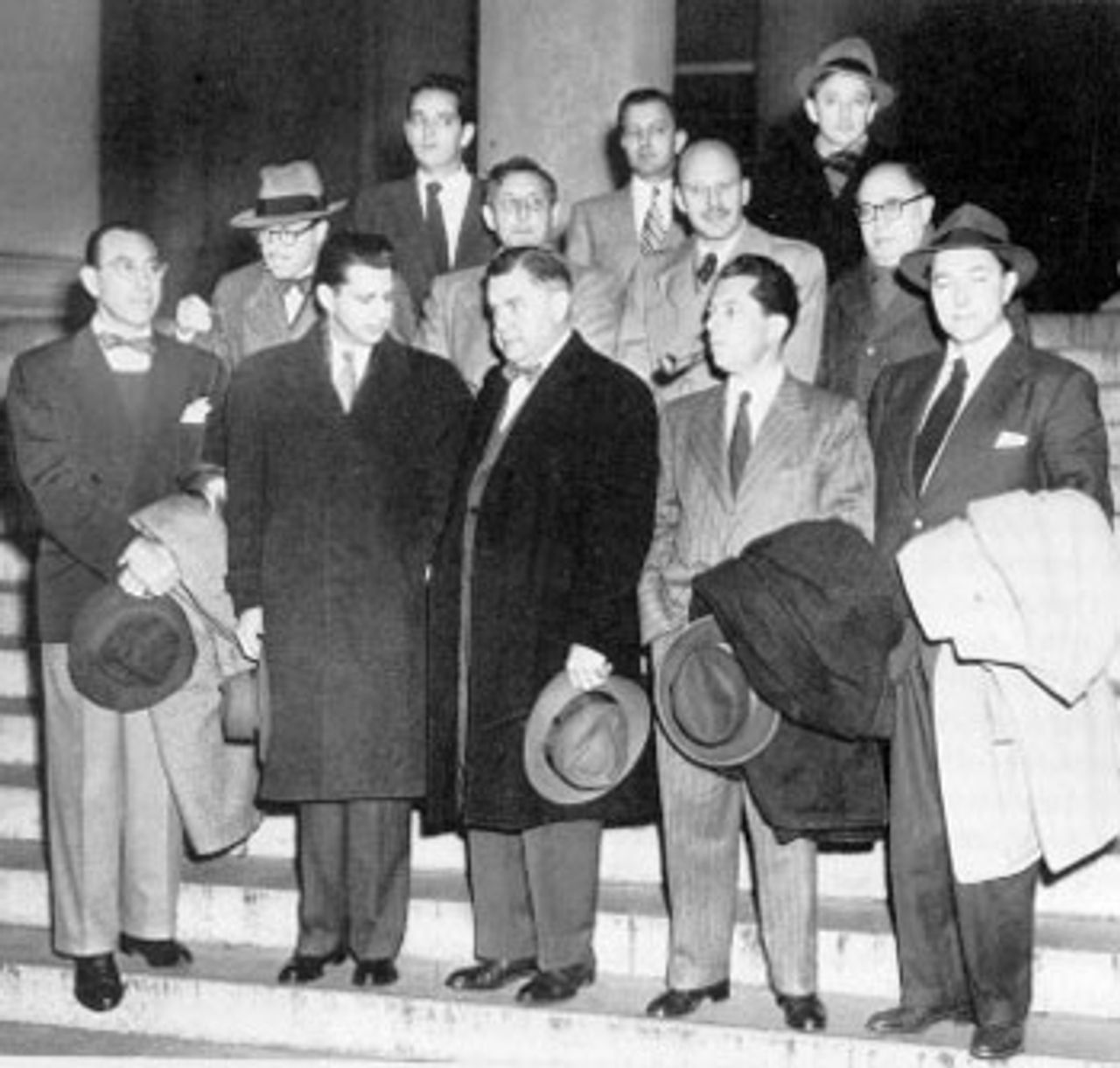 HUAC hearings — Hollywood Ten — October 1947
HUAC hearings — Hollywood Ten — October 1947
On November 25, 1947, the day after the Hollywood Ten were cited for contempt of Congress, for refusing to answer HUAC’s questions, leading studio executives and their lawyers met at the Waldorf-Astoria in New York and issued their statement launching the blacklist. They promised to discharge or suspend any of the Ten “until such time as he is acquitted or has purged himself of contempt and declares under oath that he is not a Communist” and, furthermore, the studio executives pledged not to “knowingly employ a Communist or a member of any party or group which advocates the overthrow of the government of the United States by force or by illegal or unconstitutional methods.”
Establishment liberals, like the members of the Americans for Democratic Action (ADA), solidarized themselves with the witch-hunt, only requesting that it be done somewhat less heavy-handedly. An open letter from the ADA to HUAC’s Thomas in October 1947, for example, argued, “Reckless attacks on liberals committed by the House Committee on Un-American Activities in the past have repeatedly strengthened the hand of communist agents.” (pp. 98-99)
The various unions in Hollywood, once they were rid of left-wingers, fell in line with the anti-communist offensive, including, shamefully, the Screen Writers Guild. One Hollywood newspaper reported on December 24, 1947: “Full support and cooperation in meeting and solving the communist menace in movie studios has been pledged a producers’ committee by AFL [American Federation of Labor] studio unions.” (p. 99)
By the time the second round of HUAC hearings began in March 1951, the political situation was even more unfavorable. The anti-communist hysteria had only increased in intensity in response to the Soviet Union’s explosion of an atomic bomb, the taking of power in China by Mao’s forces and the eruption of the Korean War.
Summing up those years, Humphries writes, “Politically and ideologically the Republican Right succeeded in sewing up America in general and Hollywood in particular between 1947 and 1950, with the help of a Democrat President and most liberals.” (p. 109)
The 1951-53 hearings were an even more painful repetition of the first round, with numerous “friendly” witnesses—their careers in the balance—publicly recanting their past views and associations. The penitent were asked to name the names of former comrades, to denounce the Communist Party as part “of a conspiracy for world domination” and support its outlawing and generally prostrate themselves before the committee.
The author writes, “The public acts of contrition, the eager replies to the leading questions, the humiliating coaching before and during the spectacle showed how far both HUAC and Hollywood had moved since late 1947.” (p. 119)
Humphries discusses the various films Hollywood turned out to justify the witch-hunts. The one work that endures in any serious fashion, primarily because of the performance by Marlon Brando—who had no idea he was taking part in an anti-communist film—is Elia Kazan’s On the Waterfront. The film turns reality upside down and transforms the stand-ins for the CP elements (the union thugs, led by Lee J. Cobb, an informer) into the persecutors, and the stool pigeons into the victimized. The rest of the anti-Red films Humphries discusses have largely been forgotten, except as historical curiosities.
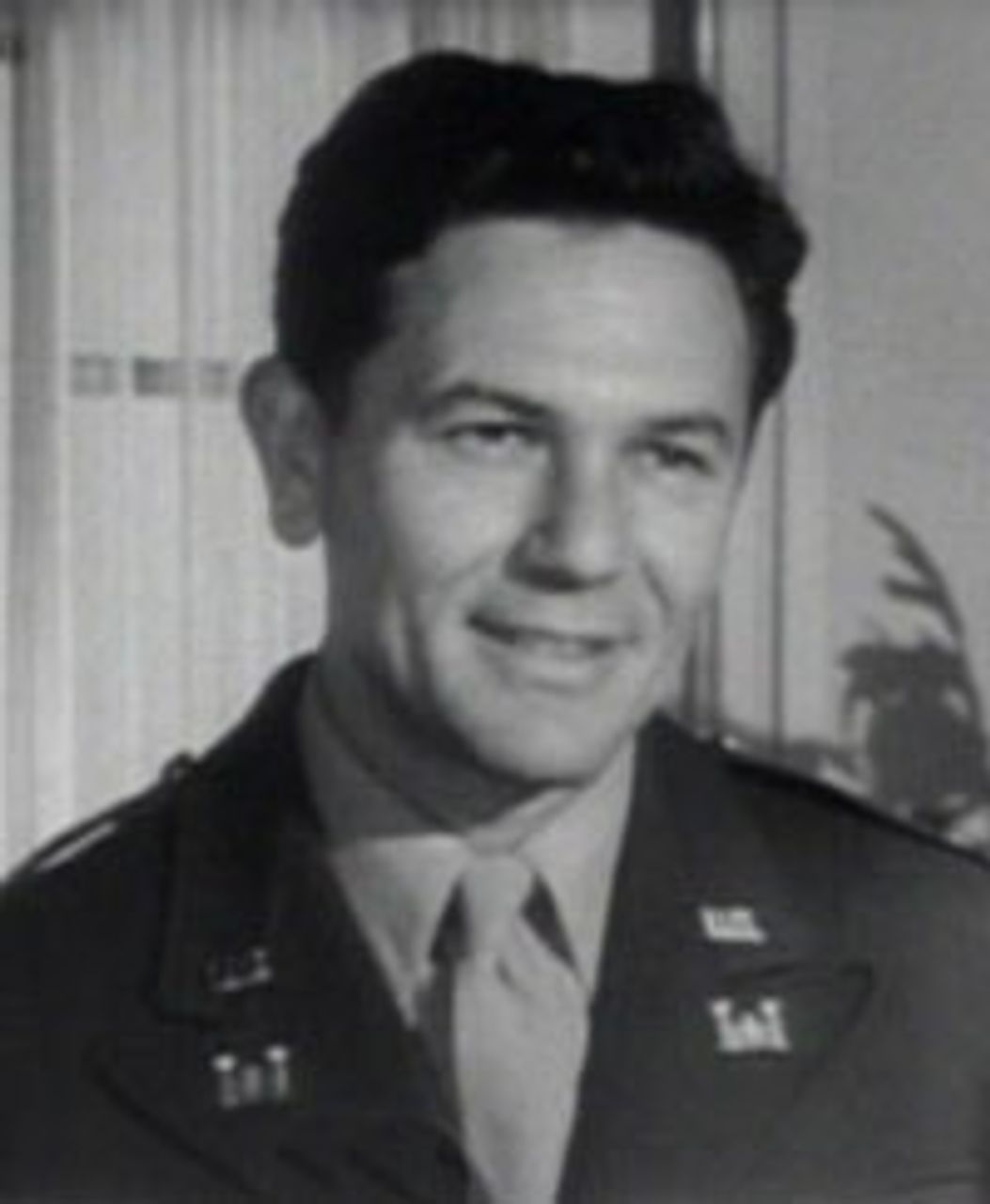 John Garfield
John Garfield
For those who resisted HUAC, varying fates awaited. Some, like J. Edward Bromberg, John Garfield and Canada Lee, physically broke under the pressure, and died. There were suicides. “Fortunately,” writes Humphries, “the vast majority of HUAC’s victims were healthy. All they had to endure was a form of ‘living death’: their transformation into non-persons.” (p.146) Numerous writers and directors found work in the theater or television in New York, others went abroad. The author suggests that still others, like John Huston, who avoided the blacklist, had the stuffing knocked out of them.
In conclusion, Humphries attempts to link the events of the late 1940s and early 1950s to subsequent developments. He suggests that the “anti-communism of liberals led to the suppression of the very laws concerning freedom of speech and thought they claimed to champion” and that “the refusal of liberals to oppose witch hunting led straight to the Vietnam War and opened the doors of the White House to Nixon.” (p. 160)
Humphries refers to new forms of McCarthyism today, the equating of those who oppose the Iraq war with supporters of Bin Laden and the vicious media attacks on New York City transit strikers in 2005. He writes, “We live, after all, in an age where the most powerful person in the world [George W. Bush] can justify torture, after having lied about ‘weapons of mass destruction’ in order to invade Iraq and thus precipitate a new crisis, all with the blessing of the supposedly liberal press.” (p. 162)
All of this history is critical, but there are certain vexing questions, with the character and role of the Communist Party at their center, that need further elaboration.
In a chapter on the “War Years,” Hollywood’s Blacklists discusses the role the film industry played from 1939-1945. After initial difficulties with “isolationists” in Congress and pressure from Production Code censor Joseph Breen, prior to US entry into World War II, “anti-fascist” and even pro-Soviet films experienced a brief flourishing during the conflict itself. Many were written or directed by Communist Party members or fellow travelers, including John Howard Lawson, John Wexley, Irving Pichel, Lester Cole, Albert Maltz, Dalton Trumbo, Lillian Hellman, Edward Dmytryk and others.
Humphries usefully discusses a number of the wartime films—including The Man I Married, Four Sons, Action in the North Atlantic, Sahara, Counter-Attack, None Shall Escape, Pride of the Marines, Tender Comrade, Watch on the Rhine, The North Star and Till the End of Time—created by Hollywood left-wingers.
No doubt the filmmakers sincerely wanted to present to an American audience the horrors and dangers of fascism, the poison of anti-Semitism and race hatred, the need for social solidarity, the power and possibility of popular action against despotism. Many indicated sympathy for the “little fellow who has suffered most” (from a review of None Shall Escape in the Hollywood Reporter, cited by Humphries, p.54). Some drew a connection between powerful business interests and authoritarian rule.
The author concludes: “If there is much flag-waving in films made during the war, whether written by future blacklistees or not, there is also much genuine radical thought and, crucially, the belief that certain values and forms of freedom had to be defended, even if that meant fighting so that others might enjoy later what one had oneself.”
This is somewhat weak, and I think Humphries tends to overvalue these films as a group. The attempt, sincere or not, to depict the Second World War as a kind of “people’s war” against fascism always rang false in the end because the reality was otherwise. The generally uncritical attitude toward the US and allied war effort; the veneration of Roosevelt (Lawson opened his script for Action in the North Atlantic, 1943, with a quote from the Democratic president); the pretense that a united and democratic America was at war against some unfathomable foreign evil; frankly, all too often the beautification of American life—all this had harmful artistic and political consequences.
Of course, a more direct and forceful critique of American society, or consistently establishing a link between capitalism and fascism, would have come up against the opposition of the studios and the media, but there is little indication that the CP writers felt an all-out battle for such themes was either necessary or advisable. Why should they have? The party’s line offered full support for Roosevelt and the “war effort.”
Much of the subsequent devastation of the Hollywood left was bound up with its misinterpretation of the world war and the Democratic administration.
From the mid-1930s, and especially in the aftermath of the 1936 election, the Communist Party—in the particular form of Popular Frontism conducted by the American Stalinists—offered their open support to the Democrats and Roosevelt. This betrayal meant the subordination of some of the most militant sections of the working class to one of America’s two big business parties.
It must be said as well that the CP and its membership had been profoundly and irretrievably compromised by the crimes of Stalinism. The Moscow Trials, the GPU murders of left-wing elements in Spain, the Stalin-Hitler Pact and other events left them politically vulnerable. In a broader intellectual sense, the CP membership had been largely indifferent to theoretical questions and tended to accept Stalinism as a brand of left-wing American radicalism.
With the German invasion of the Soviet Union in 1941, the CPUSA became the most rabid pro-war, anti-strike element in the labor movement. It enthusiastically supported the prosecution of the Trotskyists in 1941 for sedition under the Smith Act, which was later used against the Stalinists themselves. The Communist Party bitterly opposed the miners’ strike of 1943 and the mounting offensive for wages in 1944 and 1945. The CP earned the hatred of many workers for their policies during these years.
While millions went into combat motivated by the desire to defeat Hitler and fascism, World War II, in its social and economic essence, remained an imperialist war, a struggle between great power blocs for the division and re-division of the world. The US, with its vast industrial strength and reserves, could afford Roosevelt’s reformist experiments in the 1930s, but that did not make the war aims of the American ruling elite or its plans for the postwar world any less predatory or criminal.
The CP closed its eyes to the incredible brutality of the Allied forces, including the firebombing of German cities, which produced horrendous civilian casualties. The Stalinists openly endorsed the dropping of atomic bombs on Japan. The Daily Worker ran a cartoon on its front page August 9, 1945, celebrating the mass incineration in Hiroshima as part of a “one-two punch.”
Once the military alliance with the USSR and the role of the CPUSA in mobilizing and maintaining popular support for the war had served their purpose, the mask came off and the grisly visage of American imperialism, now the dominant capitalist power, appeared.
The Communist Party had promised, on the contrary, a rebirth of democracy, a New Deal on an even grander and more social democratic scale. It had recruited new members on the basis of its support for the war and for “Americanism,” and its role as the fiercest and most consistent backer of Roosevelt. Notoriously, the party played “Yankee Doodle” at its meetings, decked its platforms in the US flag and adopted the slogan: “Communism is 20th-Century Americanism.”
This crass opportunism could only help disorient and lull to sleep particularly those in the film industry who had joined during the war, when the CP sought to be part of the political mainstream. As Larry Ceplair and Steven Englund note in their work, The Hollywood Inquisition, “The dozens of men and women who entered the Hollywood branches after 1941, however, were more overtly motivated by their ‘Americanism’ and impelled forward by a leftist brand of patriotism and the wartime alliance of communism and liberal democracy.” (pp.183-84)
Such individuals found it very difficult, if not impossible, to stand up to the immense pressures once the tide turned and the Cold War began.
Humphries extends a good deal of sympathy to the victims of the witch-hunting and that is commendable. However, a justifiable sympathy should not blind anyone to the short-sighted and disastrous character of the political line pursued by the Communist Party, which had far-reaching consequences for the American workers movement.
The party was a contradictory phenomenon. As we noted, the perennial right-wing contention (and the self-justification of informers like Kazan) that the CP was nothing but an extension of brutal “Kremlin” policy was a stupid police falsehood. Thousands of sincere opponents of American capitalism joined the CP, under conditions of the widespread suffering of the Depression, believing it to be the party of the October Revolution and the vehicle for the social transformation of the US. Many acted heroically and self-sacrificingly, risking their lives in some cases, to organize workers, to fight racism, to combat poverty.
In the film industry the CP counted among its members or supporters some of the most gifted and sensitive people. They wrote, acted and directed with considerable verve and inventiveness. But they were mistrained in national-opportunist politics, with various elements of Jeffersonian populism and other native tendencies thrown in, not Marxism. They thought the Democrats, the liberals and union officials were their friends and allies, until the latter lined up, virtually to the man or woman, with their fiercest persecutors.
For American liberals, who had joined hands with the Stalinists in the 1930s when it served their purposes (including access to the working class, which they would never have had otherwise), the attack on the Communist Party served a number of purposes: it facilitated their rapprochement with American imperialism, guaranteed their control of the labor movement and also left them unopposed on cultural questions.
This was, so to speak, a Pyrrhic victory. American liberalism emerged from the witch-hunts politically an impotent and spent force. Since that period it has been continuously on the retreat, with nothing progressive or substantive to offer. There was no golden age of liberalism.
In any event, no healthy party is simply suppressed out of existence. In the end, the Communist Party, including its Hollywood section, was not destroyed by repression, but by its own internal contradictions and the inviability of its program and perspective.
The present devastating crisis will produce a new radicalization and, inevitably, a socialist current in the film industry. Settling accounts with the history Humphries treats in Hollywood’s Blacklists is indispensable.
